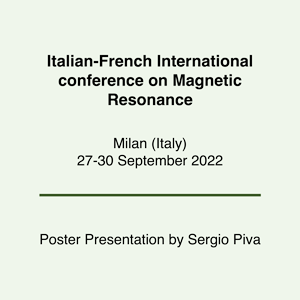Milan (Italy), 27-30 September 2022, Poster Presentation by Sergio Piva
Title: “Hyperpolarized 129Xe NMR: An Invaluable Tool to Explore Nanoporous Crystalline Structures”
Authors: S. Piva, J. Perego, C. X. Bezuidenhout, S. Bracco, P. Sozzani and A. Comotti
Abstract
Solid-state NMR (ssNMR) is an essential tool for the characterization of metal-organic frameworks (MOFs), a new and emerging class of porous hybrid materials constructed by metal-based nodes and organic ligands. While the crystal structure is commonly determined by diffraction techniques, ssNMR is the technique of choice for elucidating the dynamics of the molecular moieties comprising the material and gases diffusing inside it. High resolution ssNMR techniques are used to characterize new crystal structures. In fact, 1H, 19F and 13C MAS spectra (1D and 2D) can demonstrate the purity of the materials and monitor changes in the structural symmetry. By changing contact times, the distances and connectivity between nuclei can be evaluated, thus realizing a sort of NMR crystallography. In addition, we can investigate the porosity of MOFs using continuous-flow hyperpolarized (HP) 129Xe ssNMR, which is a laser-assisted technique that exploits 129Xe nuclei as an invaluable probe to explore the shape and size of the cavities in the porous materials. [1] Due to the very high sensitivity of this technique, we adopt extremely diluted conditions (2% Xe in He/N2 gas mixture), thus preventing room temperature Xe-Xe interactions. A neat chemical shift anisotropy (CSA) is observed for MOFs with narrow channels, while for larger cavities only the isotropic signals are collected, which give information on xenon confinement. [2] An interesting result was observed in the HP 129Xe spectra of the hetero-ligand Zr-DPT:DPA-8% MOF (DPT = 5,12-diphenyl-tetracenedicarboxylate; DPA = 9.10-diphenyl-antracenedicarboxylate), which exhibits a single peak with a chemical shift corresponding precisely to the expected weighted average of the two chemical shifts of the homo-ligand samples (see Fig. 1). The absence of any residual peak of the homo-ligand MOFs demonstrates the excellent structural homogeneity of the co-assembled frameworks. [3] References [1] P. E. Sozzani, S. Bracco, and A. Comotti in Hyperpolarized Xenon-129 Magnetic Resonance: Concepts, Production, Techniques and Applications, RSC (2015) [2] P. E. Sozzani et al. J. Mat. Chem. A 8, 11406-11413 (2020) [3] J. Perego et al. Nature Communications. Accepted (2022)

